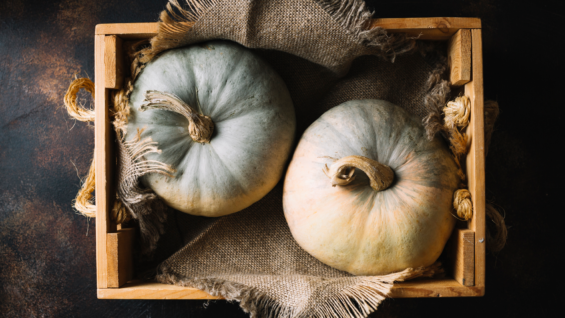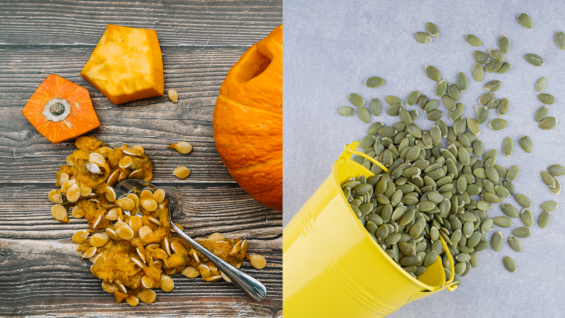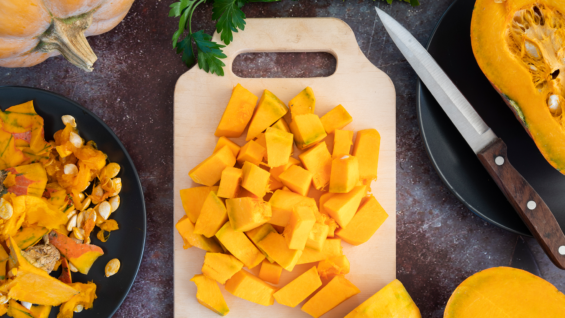Blog & News
Food waste

Do you also feel like squash are everywhere right now? They’re on front steps as decorations, spilling out on market stalls, filling grocery shelves, and of course, popping up all over social media. They really are the stars of the season.
I can’t resist them myself. I love that cozy autumn vibe, and of course, I brought some home. Squash are so versatile—they can be used in countless recipes, both sweet and savoury.
Did you give in too? Here are a few simple tips to enjoy your squash to the fullest, without letting any go to waste.
Tip #1: How to store them properly

Good news—squash last a long time without much effort. Whole, they can keep for 1 to 6 months in a cool, dry, dark place. Before storing, make sure to wash and dry them thoroughly to prevent mould. This way, you’ll always have squash ready for a comforting soup, gratin, or dessert, even in the middle of winter.
Tip #2: Eat the skin

Did you know the skin of certain squash varieties is not only edible but also delicious? Varieties like acorn, delicata, or buttercup squash have skins that become tender when cooked. The result? Less waste, more fibre, vitamins, and antioxidants, and a little extra time saved in the kitchen.
Tip #3: Roast the seeds

Instead of tossing the seeds into the compost, why not turn them into a crunchy, nutritious snack? It’s really simple:
• Wash and dry the seeds.
• Toss them with a little oil and your favourite spices—savory ones like salt, garlic powder, paprika, or cumin, or sweet ones like cinnamon, nutmeg, or maple syrup.
• Roast in the oven at 325°F for 15 to 20 minutes.
You’ve got the perfect little autumn snack! Personally, I put it in salads, granola—basically everywhere.
Tip #4: Preserve them for longer

When your squash supply starts to pile up, there are several ways to keep them around longer:
Freezing
Cut squash into small pieces and store them in airtight bags. You can also puree it and freeze in ice cube trays, perfect for muffins, soups, or sauces. For a full guide to freezing squash and other produce, check out our guide here.
Dehydrating
Slice or powder squash to add to broths, sauces, or legume dishes like dahl or curry. Learn more about dehydrating foods here.
Canning
Squash can be pressure-canned, either on their own in cubes or in a recipe. Because they’re low-acid, this method is the safest for long-term storage. Check out our step-by-step canning guide here.
Lacto-Fermentation
Lacto-fermented squash adds a tangy, vibrant touch to winter meals. Cut into cubes or thin slices (blanch firmer varieties first), add garlic, ginger, and bay leaves, and let the magic happen. Learn more about lacto-fermentation here.
I hope these tips inspire you to fully enjoy squash this season and keep the flavours going for months to come.

Food Waste Reduction, Team Manager
Kim Méthot
Having spent her childhood summers camping in the forests of Quebec, Kim quickly understood the interconnectedness and fragility of the environment that surrounds us. Every day, she seeks ways to reduce her impact on the planet and hopes that, by setting an example, others will follow suit. Passionate about cooking, Kim dreams one day of having her own garden in order to strive as much as possible towards food autonomy.
View all posts...Related posts :
Contact us
Earth Day Canada
5818, boulevard Saint-Laurent
Montréal (Québec) H2T 1T3 Canada
Phone : (514) 728-0116
Toll free : 1 800 424-8758
Fax : (514) 303-0248
Email: hello@earthday.ca
2025 © Earth Day Canada. All rights reserved.
Privacy policy · Terms of use · Trademark









